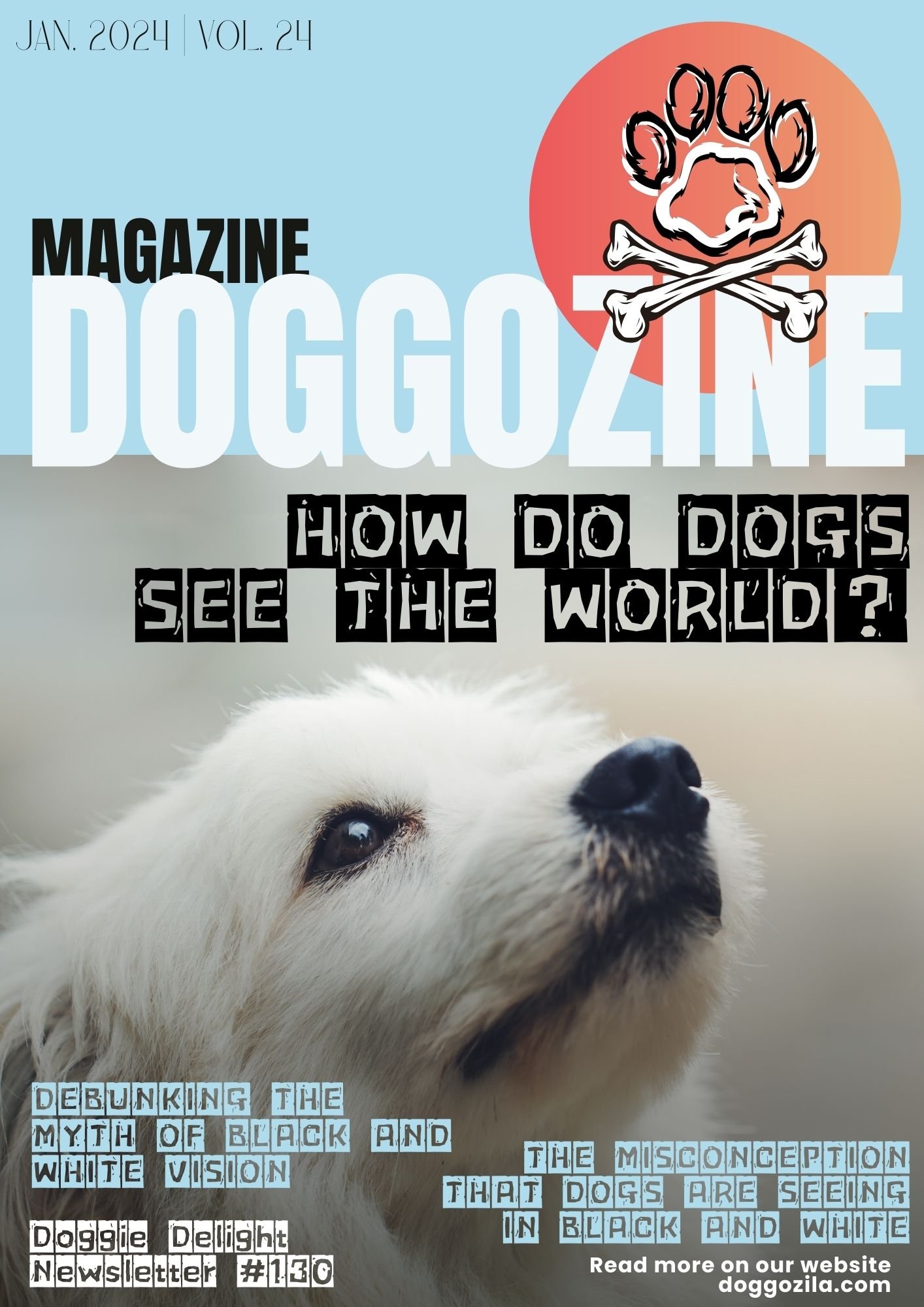
DEBUNKING THE MYTH THAT DOGS SEE THE WORLD WITH BLACK AND WHITE VISION
Have you ever wondered how do dogs see the world around them? There’s a common belief that dogs see everything in black and white, but is that really true? In this blog post, we will explore the fascinating world of dog vision and debunk the myth of black and white vision.
Understanding Dog Vision
While it is true that dogs have different visual capabilities compared to humans, their vision is far from being limited to black and white. Dogs have a unique visual system that allows them to see a range of colors, although not as vividly as humans.
Research has shown that dogs have dichromatic vision, meaning they have two types of color receptors in their eyes, called cones. Humans, on the other hand, have trichromatic vision, with three types of cones that enable us to perceive a wider spectrum of colors.
Color Perception in Dogs
So, if dogs can see colors, how do they perceive them? While humans can distinguish between a variety of colors, dogs have a more limited color palette. They primarily see the world in shades of blue and yellow, with some ability to perceive green and gray tones.
Red and orange colors, which appear vibrant to us, may appear as shades of yellow or brown to dogs. This is because the wavelength of these colors is longer and falls outside the range of their color vision. However, dogs can still differentiate between various shades of blue and yellow, allowing them to navigate their environment effectively.
Visual Acuity and Motion Detection
Although dogs may not have the same level of color perception as humans, their visual acuity and motion detection abilities are remarkable. Dogs have a higher number of rod cells in their eyes compared to humans, which enhances their ability to detect movement, even in low light conditions.
This heightened motion detection is one of the reasons why dogs excel in activities such as tracking, herding, and playing fetch. Their keen sense of motion allows them to quickly spot prey or a thrown ball, even from a distance.
Peripheral Vision and Depth Perception
Another interesting aspect of canine vision is their wide field of view. Dogs have a larger visual field than humans, enabling them to see more of their surroundings without having to turn their heads. This wide peripheral vision is particularly useful for hunting and detecting potential threats.
However, while dogs have excellent peripheral vision, their depth perception may not be as accurate as ours. Their snouts and the position of their eyes on the sides of their heads can affect their depth perception to some extent. This is why you might notice your dog misjudging the distance while trying to catch a treat in mid-air.
Low Light Vision and Night Vision
Have you ever been amazed at how well your dog can see in the dark? Dogs have a specialized structure in their eyes called the tapetum lucidum, which reflects light back through the retina. This enhances their ability to see in low light conditions, making them well-suited for activities such as night-time walks or hunting during dawn and dusk.
Dogs can’t see colors as bright as humans, but they see better in dim light. This night vision helped dogs survive long ago. That’s why dogs make great company for late-night outings.
Dogs’ special eyesight
It’s true that dogs don’t see the world in black and white. While their color vision isn’t as good as ours, they can tell apart some blues and yellows. Dogs have unique vision skills like seeing movements well, wide side vision, and excellent night vision.
So, when you walk your furry buddy, remember they view the world their own colorful way, with shades of blue and yellow. Understanding their special eyesight deepens our bond with our dog friends.

THE MYTH THAT DOGS SEE THE WORLD ONLY BLACK AND WHITE
Have you ever wondered why some people think dogs only see black and white? It’s a long-held but untrue idea. Let’s look at where this myth began and the cool reality of how dogs actually view things.

WHERE THE MYTH STARTED
The belief that dogs see only black and white traces back to when not much was known about animal vision. Early studies focused on human vision and some pets like cats and dogs. Researchers found humans have three color detectors in our eyes to see a wide range of colors. Studies once thought dogs only had two types of color receptors. This led many to assume dogs saw everything in black and white, because they were colorblind. For years, this idea was accepted as fact.
The Reality of Dog Vision
New research shows dogs aren’t completely colorblind. While dogs have fewer color receptors than humans, they can still see some colors. Dogs just have a more limited range.
Humans have three types of color receptors, called cones. These let us see red, green and blue – the full color spectrum. Dogs only have two cone types, giving them reduced color vision.
Studies reveal dogs are most sensitive to blue and yellow shades. Dogs struggle telling red and green apart. This means dogs likely see the world in blues, yellows and grays.
How Dogs Use Their Senses
Though dogs don’t see like humans, they use other sharp senses. Dogs heavily rely on their smell and hearing to move through their world. These heightened abilities make up for limited color vision.
Dogs have an incredibly keen sense of smell, which allows them to detect scents that are undetectable to humans. They use their sense of smell to identify objects, locate food, and even detect illnesses or changes in their human companions. This heightened sense of smell is one of the reasons why dogs are often used in search and rescue operations and as service animals.
In addition to their sense of smell, dogs also have excellent hearing. They can hear a wider range of frequencies than humans, which allows them to detect sounds that are inaudible to us. This heightened sense of hearing helps dogs to detect approaching danger, locate prey, and communicate with other dogs through barks and howls.
Debunking the Myth that Dogs see the world black and white
Now that we understand that dogs do not see in black and white, it’s important to debunk this myth and spread accurate information about dog vision. While dogs may not perceive colors in the same way humans do, they are still capable of seeing certain colors and shades.
Next time someone mentions that dogs see in black and white, you can confidently correct them and share the fascinating reality of how dogs perceive the world around them. Dogs may have a different color perception, but their other senses, such as smell and hearing, more than make up for it.
Dogs Can See Colors
The belief that dogs see in black and white is a long-standing myth that has been debunked by scientific research. While dogs may have a more limited color perception compared to humans, they are not colorblind. Dogs can see colors, albeit in a different range, and rely on their other senses, such as smell and hearing, to navigate their environment. Understanding how dogs perceive the world around them allows us to appreciate their unique abilities and strengthen the bond between humans and our beloved canine companions.

HOW DOGS USE THEIR SENSES TO NAVIGATE AND SEE THE WORLD
Dogs may not see the world in the same way humans do, but they have other senses that help them navigate and understand their surroundings. While their vision may not be as sharp as ours, dogs rely on their acute hearing, sense of smell, touch, and even their ability to sense vibrations to make sense of the world around them.
Dog Hearing
One of the most remarkable senses dogs possess is their hearing. Dogs have a much wider range of hearing than humans, allowing them to detect sounds that are beyond our auditory range. They can pick up on high-pitched frequencies and even hear sounds from a much greater distance. This heightened sense of hearing helps dogs detect approaching dangers, locate prey, and even understand human commands.
Dog Smell
Dogs are renowned for their exceptional sense of smell. In fact, their sense of smell is estimated to be up to 100,000 times more powerful than ours. Dogs have a specialized organ called the vomeronasal organ, also known as Jacobson’s organ, which allows them to detect and analyze scents in a way that humans cannot. This incredible olfactory ability enables dogs to track scents, identify specific odors, and even detect diseases or drugs.
Dog Touch
While touch may not be as prominent a sense for dogs compared to their hearing and smell, it still plays a crucial role in their perception of the world. Dogs have sensitive nerve endings in their skin, especially in their paws, muzzle, and ears. Through touch, dogs can gather information about their environment, such as the texture of surfaces, the presence of obstacles, and even the emotions of other animals or humans through physical contact.
Vibrations
Dogs have the special ability to feel vibrations. This helps them understand when things move around them. Vibrations travel through their paws and bodies. Dogs can sense nearby objects, other animals moving, and even earthquakes or thunderstorms by feeling these vibrations.
Compensating for Vision
Dogs may not see as clearly as humans. But they make up for this with their other sharp senses. Their amazing hearing and smell skills let them learn about their surroundings. For example, a dog can recognize their owner’s scent or footstep sounds.
Along with senses, dogs use instincts and memory to find their way. They can remember familiar smells, places, and routes naturally. Dogs adapt well using this mix of senses, instincts, and memories.
Quick Summary On How Do Dogs See The World
Dogs view the world differently than people. But they have impressive senses that guide them. Great hearing, smell, touch, and feeling vibrations are vital for dogs. Using these senses helps make up for limited vision. Dogs interact uniquely with their environment thanks to these special abilities.










